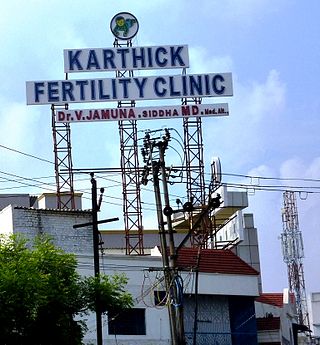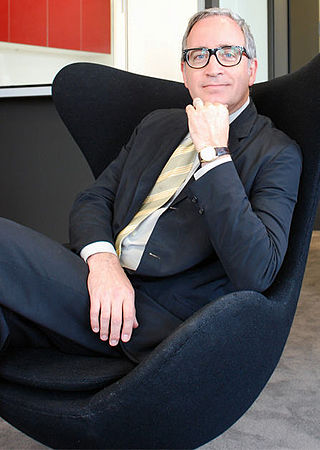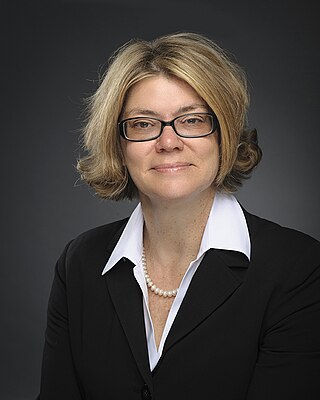
A spermatozoon is a motile sperm cell, or moving form of the haploid cell that is the male gamete. A spermatozoon joins an ovum to form a zygote.

In vitro fertilisation (IVF) is a process of fertilisation where an egg is combined with sperm in vitro. The process involves monitoring and stimulating a woman's ovulatory process, removing an ovum or ova from their ovaries and letting a man's sperm fertilise them in a culture medium in a laboratory. After the fertilised egg (zygote) undergoes embryo culture for 2–6 days, it is transferred by catheter into the uterus, with the intention of establishing a successful pregnancy.
Reproductive technology encompasses all current and anticipated uses of technology in human and animal reproduction, including assisted reproductive technology (ART), contraception and others. It is also termed Assisted Reproductive Technology, where it entails an array of appliances and procedures that enable the realization of safe, improved and healthier reproduction. While this is not true of all people, for an array of married couples, the ability to have children is vital. But through the technology, infertile couples have been provided with options that would allow them to conceive children.

Intracytoplasmic sperm injection is an in vitro fertilization (IVF) procedure in which a single sperm cell is injected directly into the cytoplasm of an egg. This technique is used in order to prepare the gametes for the obtention of embryos that may be transferred to a maternal uterus. With this method, the acrosome reaction is skipped.

Infertility is the inability of an animal or plant to reproduce by natural means. It is usually not the natural state of a healthy adult, except notably among certain eusocial species. It is the normal state of a human child or other young offspring, because they have not undergone puberty, which is the body's start of reproductive capacity.

A sperm bank, semen bank, or cryobank is a facility or enterprise which purchases, stores and sells human semen. The semen is produced and sold by men who are known as sperm donors. The sperm is purchased by or for other persons for the purpose of achieving a pregnancy or pregnancies other than by a sexual partner. Sperm sold by a sperm donor is known as donor sperm.
Sperm washing is the process in which individual sperms are separated from the semen. Washed sperm is used in artificial insemination using the intrauterine insemination (IUI) technique and in in vitro fertilization (IVF). It may also be used to decrease the risk of HIV transmission by an HIV-positive male, in which case the washed sperm is injected into a female using an artificial insemination technique.
Hypospermia is a condition in which a man has an unusually low ejaculate volume, less than 1.5 mL. It is the opposite of hyperspermia, which is a semen volume of more than 5.5 mL. It should not be confused with oligospermia, which means low sperm count. Normal ejaculate when a man is not drained from prior sex and is suitably aroused is around 1.5–6 mL, although this varies greatly with mood, physical condition, and sexual activity. Of this, around 1% by volume is sperm cells. The U.S.-based National Institutes of Health defines hypospermia as a semen volume lower than 2 mL on at least two semen analyses.
Male infertility refers to a sexually mature male's inability to impregnate a fertile female. In humans, it accounts for 40–50% of infertility. It affects approximately 7% of all men. Male infertility is commonly due to deficiencies in the semen, and semen quality is used as a surrogate measure of male fecundity. More recently, advance sperm analyses that examine intracellular sperm components are being developed.

Reproductive medicine is a branch of medicine concerning the male and female reproductive systems. It encompasses a variety of reproductive conditions, their prevention and assessment, as well as their subsequent treatment and prognosis.

Fertility clinics are medical clinics that assist couples, and sometimes individuals, who want to become parents but for medical reasons have been unable to achieve this goal via the natural course. Clinics apply a number of diagnosis tests and sometimes very advanced medical treatments to achieve conceptions and pregnancies.

A semen analysis, also called seminogram or spermiogram, evaluates certain characteristics of a male's semen and the sperm contained therein. It is done to help evaluate male fertility, whether for those seeking pregnancy or verifying the success of vasectomy. Depending on the measurement method, just a few characteristics may be evaluated or many characteristics may be evaluated. Collection techniques and precise measurement method may influence results. The assay is also referred to as ejaculate analysis, human sperm assay (HSA), sperm function test, and sperm assay.

Ann Kiessling is an American reproductive biologist and a researcher in human parthenogenic stem cell research at The Bedford Research Foundation. She was an associate professor in teaching hospitals of Harvard Medical School from 1985 until 2012.
The Special Program of Assisted Reproduction (SPAR) is a program offered to HIV discordant couples (serodiscordant) at the Bedford Research Foundation's clinical laboratory. The program takes advantage of ART procedures to assist couples achieve a pregnancy who would otherwise risk transmitting the father's HIV infection to the mother and the child through intercourse.

Ejaculation is the discharge of semen from the penis through the urethra. It is normally linked with orgasm, which involves involuntary contractions of the pelvic floor. It is the final stage and natural objective of male sexual stimulation, and an essential component of natural conception. Ejaculation can occur spontaneously during sleep, and is a normal part of human sexual development. In rare cases, ejaculation occurs because of prostatic disease. Anejaculation is the condition of being unable to ejaculate. Ejaculation is normally intensely pleasurable for men; dysejaculation is an ejaculation that is painful or uncomfortable. Retrograde ejaculation is the backward flow of semen into the bladder rather than out of the urethra.

Dr. Paul J Turek is an American physician and surgeon, men's reproductive health specialist, and businessman. Turek is a recent recipient of a National Institutes of Health (NIH) grant for research designed to help infertile men become fathers using stem cells.

Ashok Agarwal is the Director of the Andrology Center, and also the Director of Research at the American Center for Reproductive Medicine at Cleveland Clinic, Cleveland, USA. He is Professor at the Cleveland Clinic Lerner College of Medicine of Case Western Reserve University, USA. Ashok is a Senior Staff in the Cleveland Clinic's Glickman Urological and Kidney Institute. He has published extensive translational research in human infertility and assisted reproduction.
In sperm banks, screening of potential sperm donors typically includes screening for genetic diseases, chromosomal abnormalities and sexually transmitted infections (STDs) that may be transmitted through the donor's sperm. The screening process generally also includes a quarantine period, during which samples are frozen and stored for at least six months after which the donor will be re-tested for STIs. This is to ensure no new infections have been acquired or have developed during since the donation. If the result is negative, the sperm samples can be released from quarantine and used in treatments.
Simon Fishel is an English physiologist, biochemist and pioneering in vitro fertilisation (IVF) specialist.

Renee Reijo Pera is a stem cell biologist and the President of the McLaughlin Research Institute in Great Falls, MT. She previously served as Vice President of Research and Economic Development, for more than 8 years at the California Polytechnic State University and at Montana State University. Reijo Pera's research focuses on human development and disease, in particular, on the development and differentiation of somatic and germ cell lineages and neurodegenerative diseases such as Parkinson's disease and also infertility in men and women.












